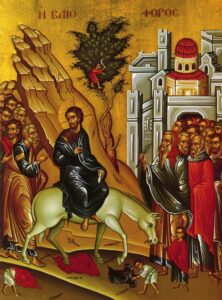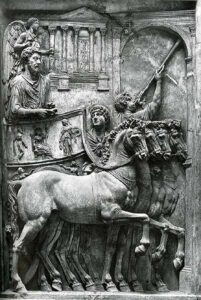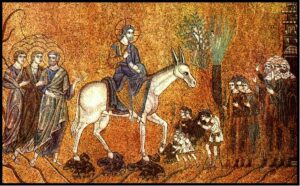
Behold, Your King is coming! source
This year while Protestants and Roman Catholics have already celebrated Palm Sunday, for Orthodox Christians Palm Sunday still lies ahead.
Palm Sunday is a familiar event for many Christians but it is a profound multi-layered event that has much to teach us about our God and Savior Jesus Christ.
In Matthew’s Gospel we read a quote from the prophet Zechariah:
Behold, your King is coming to you, Lowly, and sitting on a donkey, A colt, the foal of a donkey.
(Matthew 21:5; Zechariah 9:9, OSB)
Early Christians viewed Jesus’ death and resurrection from the standpoint of Christus Victor (Christ the Conqueror). But all too often we forget or overlook that Jesus Christ is unlike worldly conquerors.

Marcus Aurelius shown in a four horse chariot. Source
Unlike Roman emperors who entered triumphantly riding a chariot drawn by war horses, Jesus enters Jerusalem riding a donkey — a sign of humility.
Cyril of Jerusalem in his Catechetical Lectures used Zechariah 9:9 to drive home the point the uniqueness of Christ’s kingship.
Kings are many; of which do you speak, O Prophet? Give us a sign which other Kings have not. If you say, A king clad in purple, the dignity of the apparel has been anticipated. If you say, Guarded by spear-men, and sitting in a golden chariot, this also has been anticipated by others. Give us a sign peculiar to the King whose coming you announce. And the Prophet makes answer and says, Behold! Your King comes unto you, just, and having salvation: He is meek, and riding upon an ass and a young foal, not on a chariot. You have a unique sign of the King who came. Jesus alone of kings sat upon an unyoked foal, entering into Jerusalem with acclamations as a king. (Lecture 12.10)
The Orthodox Matins Service for Palm Sunday has an interesting allegorical interpretation of Jesus riding the foal.
O Thou who ridest on the cherubim and art praised by the seraphim, Thous hast sat, O gracious Lord, like David on a foal, and the children honored Thee with praise fitting for God; but the Jews blasphemed unlawfully against Thee. Thy riding on a foal prefigured how the Gentiles, as yet untamed and uninstructed, were to pass from unbelief to faith. Glory be to Thee, O Christ, who alone art merciful and lovest mankind. (Lenten Triodion p. 492)
Thus, there is in Jesus’ entry into Jerusalem a missionary message — that Christ came to save not only the Jews but also the Gentiles. With Christ’s entry into Jerusalem the Old Covenant of Moses reaches its conclusion and a New Covenant commences. The Old Israel is superseded by the New Israel:
Let us also come today, all the new Israel, the Church of the Gentiles, and let us cry with the Prophet Zechariah; Rejoice greatly, O daughter of Zion; shout aloud, O daughter of Jerusalem; for behold, thy King comes unto thee . . . . (Lenten Triodion p. 489)
In his Catechetical Lectures Cyril also sees Jesus entry into Jerusalem as fulfilling another prophecy in Zechariah 14:4, a favorite verse among Evangelicals who view it in light a literal 7 year Tribulation, the Antichrist, and the Second Coming. (See Calvary Chapel’s founding father Chuck Smith’s dispensationalist commentary.) Cyril of Jerusalem in his Catechetical Lecture notes:
But He might perchance even sit upon a foal: give us rather a sign, where the King that enters shall stand. And give the sign not far from the city, that it may not be unknown to us: and give us the sign plain before our eyes, that even when in the city we may behold the place. And the Prophet again makes answer, saying: And His feet shall stand in that day upon the Mount of Olives which is before Jerusalem on the east. Does any one standing within the city fail to behold the place? (Lecture 12.11)
An Invitation
Palm Sunday is an invitation to worship Jesus Christ. Just as the Jews and the city of Jerusalem were given the opportunity to receive Christ as King so too the opportunity is given to all today. We find in Canticle One Palm Sunday viewed from the Christus Victor motif:
Out of the mouth of Thy servants, the innocent babes and sucklings, Thou hast received praise. Thou hast overthrown the adversary and by Thy Passion on the Cross Thou hast avenged Adam’s fall of old; with the Tree Thou hast raised him up, and he sings to Thee, O Lord, a hymn of victory.
(Lenten Triodion p. 496)
Robert Arakaki
Resources
The Lenten Triodion. Edited by Mother Mary and (Metropolitan) Kallistos Ware.

Does Cyril understand the entirety of Zech. 14:4 as being fulfilled in Christ, particularly the second half of the verse?
**and the Mount of Olives will be split in its middle from east to west by a very large valley, so that half of the mountain will move toward the north and the other half toward the south.**
Jacob,
Good question. My guess is that Cyril of Jerusalem would want to see the entirety of Zechariah 14:4 being fulfilled by Christ. This would be consistent with the Christo-centric focus of his Catechetical Lectures.
But I’m guessing you are probably also wondering how Cyril would interpret the part about the mountain being split in half. I did a search of Cyril’s Catechetical Lectures and drew a blank. I did a quick Internet search of what some of the Church Fathers had to say about this puzzling passage and also drew a blank. Maybe someone out there knows of a Church Father who has dealt with this passage.
Expanding the search to other commentaries I found a nice commentary note in The Geneva Bible: “By this manner of speech the Prophet shows God’s power and care over his Church, and how he will as it were by a miracle save it.”
Calvin wrote:
I like Luther’s brutal honesty. In the face of the difficulties of interpreting Zechariah 14 Luther wrote: “Here, in this chapter, I give up. For I am not sure what the prophet is talking about.” (Wolters p. 41)
You might find informative Al Wolters’ article: “Zechariah 14: A Dialogue with the History of Interpretation” in the Mid-America Journal of Theology 2002: 39-56 which was presented to the Mid-America Reformed Seminary on November 8, 2000. In this article Wolters gives a historical overview of how Zechariah 14 has been interpreted. He notes that Dispensationalism’s literal interpretation is a very recent development. Curiously, Wolters’ historical overview failed to take into account Cyril of Jerusalem’s use of Zechariah in his Catechetical Lectures.
Robert
Thanks for the Wolters link. I used to read Al back in the day. Yeah, I disagree with Calvin and Geneva on this. The reason I ask is that Zech. 14 is functionally the same as Revelation 19-20 in the history of hermeneutics.
My own take, and I read Zech. 14 in a sequential manner, is Christ’s returning and his feet splitting the mountain is his second coming to establish a millennial reign (and probably his saving Jerusalem at the first battle of Magog).
Jacob,
Glad you appreciated the Wolters link. Let’s keep our focus on Holy Week and Christ’s Resurrection. Wishing you a blessed Easter/Pascha!
Robert
Hi All,
Just to let you know that Dr. Wolters recently published a commentary on Zechariah. I think it was at least 20 years in the works.
http://www.amazon.com/Zechariah-Historical-Commentary-Old-Testament/dp/9042930705
Often Christ riding on donkey is described as representing humility. But at least a few times in the historical books, riding a donkey is connected to the king or the king’s sons, if I recall correctly. (no references immediately at hand) My thought is that this is symbolism that the Jews would catch, or am I out in left field here?
George,
I’m sure the Jews of Jesus’ time caught on right away. So you’re right on that point. But I think for many moderns the symbol of humility might be missed. For me the humbleness of Jesus’ riding the donkey became clear when I saw how it contrasted with a Roman general riding in on a war horse. Or to use a modern day reference I am reminded of Jimmy Carter’s symbolic walk from the East Portico of the nation’s Capitol to the White House. This I understand represented a symbolic contrast to Richard Nixon’s imperial presidency.
Robert
It’s interesting you say that, since Saul was looking for donkeys which indirectly led to his getting crowned king.